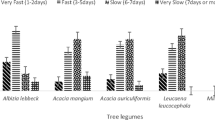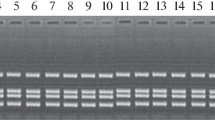Abstract
In the course of a study on rhizobia nodulating six indigenous legume shrubs from the Canary Islands, one Rhizobium and 27 Bradyrhizobium Canarian isolates were characterised. It was found that those ascribed to Bradyrhizobium were promiscuous and formed effective nodules not only in their original host but on Chamecytisus proliferus subsp. proliferus (Tagasaste) as well. However, Rhizobium isolate RES-1 was more specific and only nodulated on its host (Teline canariensis). The serotyping of these isolates required a broad antisera panel due to the great antigenic diversity of these rhizobia, that appeared to be due to differences in their lipopolysaccharides, the main antigenic determinants, that showed great structural diversity. The 28 isolates studied produced 22 easily distinguishable electrophoretic profiles of lipopolysaccharides. Protein or plasmid electrophoretic profiles were equally or less discriminating than the lipopolysaccharides profiles and were more difficult to compare. The comparison of the lipopolysaccharide electrophoretic patterns is a more reliable and discriminating method than serotyping or electrophoretic protein and plasmid profile analysis for the identification of Bradyrhizobium strains. No correlation between the lipopolysaccharide profiles of the isolates and the plant from which they were obtained or their geographical origin was observed.
Similar content being viewed by others
References
Acebes-Ginovés J R, Del Arco Aguilar M and Wilpret de la Torre W 1991 Revisión taxonómica de Chaemaecytisus proliferus(L. Fil) link en Canarias. Vieraea 20, 191-202.
Asanuma S, Thottappilly G, Ayanaba A and Ranga Pao V 1985 Use of the enzyme-linked immunosorbent assay (ELISA) in the detection of Rhizobiumboth in culture and from root nodules of soybeans and cowpeas. Can. J. Microbiol. 31, 524-528.
Barnett Y M 1991 Ecology of root-nodule bacteria. InBiology and Biochemistry of Nitrogen Fixation. Eds. M J Dilworth and A R Glenn. pp 199-228. Elsevier Sci. Publ., Amsterdam.
Bromfield E S P, Thurman N P, Whitwill S T and Barran L R 1987 Plasmids and symbiotic effectiveness of representative phage types from indigenous populations of Rhizobium meliloti. J.Gen. Microbiol. 133, 3457-3466.
Carlson R W 1984 Heterogeneity of Rhizobiumlipopolysaccharides. J. Bacteriol. 158, 1012-1017.
Carrion M, Bhat U R, Reuhs B and Carlson R W 1990 Isolation and characterization of the lipopolysaccharides from Bradyrhizobium japonicum. J. Bacteriol. 172, 1725-1731.
Corzo J, León-Banios M, Hernando-Rico V and Gutiérrez-Navarro A M 1994 Precipitation of metallic cations by the acidic exopolysaccharides from Bradyrhizobium japonicumand Bradyrhizobium(Chamaecytisus) strain BGA-1. Appl. Environ. Microbiol. 60, 4531-4536.
De Maagd R, van Rossum C and Lugtenberg B J J 1988 Recognition of individual strains of fast-growing rhizobia by using profiles of membrane proteins and lipopolysaccharides. J. Bacteriol. 170, 3782-3785.
De Maagd R, de Rijk R, Mulders I H M and Lugtenberg B J J 1989 Immunological characterization of Rhizobium leguminosarumouter membrane antigens by use of polyclonal and monoclonal antibodies. J. Bacteriol. 171, 1136-1142.
Espuny M R, Ollero F J, Bellogín R A, Ruiz-Sainz J E and Pérez-Silva J 1987 Transfer of the Rhizobium leguminosarumbiovar trifoliisymbiotic plasmid pRtr5a to a strain of Rhizobiumsp. that nodulates on Hedysarum coronarium. J. Appl. Bacteriol. 63, 13-20.
Gross D C, Vidaver A K and Klucas R V 1979 Plasmid, biological properties and efficacy of nitrogen fixation in Rhizobium japonicumstrains indigenous to alkaline soils. J. Genet. Microbiol. 114, 257-266.
Hartmann A and Amarger N 1991 Genotypic diversity of an indigenous Rhizobium melilotifield population assessed by plasmid profiles, DNAfingerprinting, and insertion sequence typing. Can. J. Microbiol. 37, 600-608.
Hewitt E J 1952 Sand and water culture methods used in the study of plant nutrition. Tech. Comm. 22. Farnhan Royal Brahs Commonwealth Agricultural Bureau.
Hitchcock P J and Brown T M 1983 Morphological heterogeneity among Salmonellalipopolysaccharides chemotypes in silver-stained polyacrylamide gels. J. Bacteriol. 154, 269-277.
Irisarri P, Milnitsky F, Monza J and Bedmar E J 1996 Characterization of rhizobia nodulating Lotus subbiflorusfrom Uruguayan soils. Plant Soil 180, 39-47.
Kamicker B J and Brill W J 1986 Identification of Bradyrhizobium japonicumnodule isolates from Winsconsin soybean farms. Appl. Environ. Microbiol. 51, 487-492.
Laemlii U K 1970 Cleavage of structural proteins during the assembly of the head of bacteriophage T4. Nature (London) 227, 680- 685.
León-Barrios M, Gutiérrez-Navarro A M, Pérez-Galdona R and Corzo J 1991 Characterization of Canary Island isolates of Bradyrhizobiumsp. Chamaecytisus proliferus). Soil Biol. Biochem. 23, 487-489.
Lie T A, Göktan D, Engin M, Pijnenborg J and Anlarsal E 1987 Co-evolution of the legume-Rhizobiumassociation. Plant Soil 100, 171-181.
Lindström K, Lipsanen P and Kaijalainen K 1990 Stability of markers used for identification of two Rhizobium galegaeinoculant strains after five years in the field. Appl. Environ. Microbiol. 56, 444-450.
Lindström K and Zahran H Z 1993 Lipopolysaccharide patterns in SDS-PAGE of rhizobia that nodulates leguminous trees. FEMS Microbiol. Lett. 107, 327-330.
Martínez de Drets G and Arias A 1972 Enzymatic basis for differentiation of Rhizobiuminto fast-and slow-growing groups. J. Bacteriol. 109, 467-470.
Noel K D and Brill W J 1980 Diversity and dynamics of indigenous Rhizobium japonicumpopulations. Appl. Environ. Microbiol. 40, 931-938.
Olsen P, Wright S, Collins M and Rice W 1994 Patterns of reactivity between a panel of monoclonal antibodies and forage Rhizobiumstrains. Appl. Environ. Microbiol. 60, 654-661.
Ovalle C, Longeri L, Aronson J, Herrera A and Avendaño J 1996 N2-fixation, nodule efficiency and biomass accumulation after two years in three Chilean legume trees and Tagasaste Chamaecytisus proliferussubsp. palmensis. Plant Soil 179, 131-140.
Pérez de Paz P L, Del Arco M, Acebes J R and Wildpret W 1986 Leguminosas forrajeras de Canarias. Aula de Cultura de Tenerife, Santa Cruz de Tenerife.
Puvanesarajah V, Schell F M, Gerhold D and Stacey G 1987 Cell surface polysaccharides from Bradyrhizobium japonicumand a non-nodulating mutant. J. Bacteriol. 169, 137-141.
Siverio F, Cambra M, Gorris M T, Corzo J and López M M 1993 Lipopolysaccharides as determinants of serological variability in Pseudomonas corrugata. Appl. Environ. Microbiol. 59, 1805- 1812.
Snook L C 1986 Tagasaste (tree lucerne), high production fodder crop. Night Owl Pub., Shepparton.
Towbin H, Staehelin T and Gordon J 1979 Electrophoretic transfer of proteins from polyacrylamide gels to nitrocellulose sheets: procedure and some applications. Proc. Nat. Acad. Sci. USA 76, 4350-4354.
Tsai C M and Frasch C E 1982 Asensitive silver staining for detecting lipopolysaccharides in polyacrylamide gels. Anal. Biochem. 119, 115-119.
Vincent J M 1970 A Manual for the Practical Study of Root-nodule Bacteria. IBP Handbook No. 15. Blackwell Sci. Publ., Oxford.
Weger L A, Jann B, Jann K and Lugtenberg D 1987 Lipopolysacharides of Pseudomonasspp. that stimulate plant growth: composition and use for strain identification. J. Bacteriol. 169, 1441-1446.
Author information
Authors and Affiliations
Rights and permissions
About this article
Cite this article
Santamaria, M., Corzo, J., Leon-Barrios, M. et al. Characterisation and differentiation of indigenous rhizobia isolated from Canarian shrub legumes of agricultural and ecological interest. Plant and Soil 190, 143–152 (1997). https://doi.org/10.1023/A:1004247803116
Issue Date:
DOI: https://doi.org/10.1023/A:1004247803116




